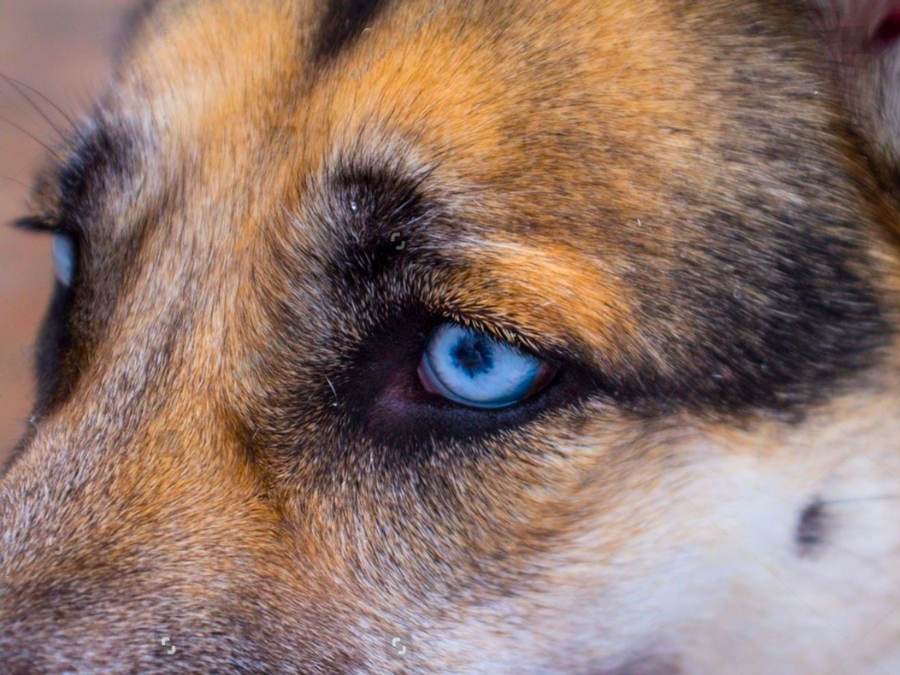Although most German Shepherds boast a pair of deep brown eyes, a rare genetic twist can gift some German Shepherds with striking blue eyes, a trait that captivates and intrigues many enthusiasts and potential dog owners.
This blog post delves into the phenomenon of blue eyes in German Shepherds, exploring the genetics behind this rare trait, the price of a blue-eyed German Shepherd, and where you can buy one for yourself.
Can a German Shepherd Have Blue Eyes?
Yes, a German Shepherd can have blue eyes, but it is quite rare. Typically, German Shepherds are known for their brown eyes, ranging from light to dark shades.
The most common reason for blue eyes in dogs is genetic. In German Shepherds, blue eyes can be caused by a genetic mutation unrelated to the merle gene, which is responsible for blue eyes in some other dog breeds.
A mutation in the gene named ALX4 on canine chromosome 18 has been identified in some studies as being associated with blue eyes in certain dog breeds.
How Does Merle Gene Affect a GSD’s Eye Color?
The merle gene causes mottled patches of color in a dog’s coat and can affect eye color, leading to blue or odd-colored eyes (one blue eye and one brown eye).
However, traditional purebred German Shepherds do not carry the merle gene. If a German Shepherd exhibits the merle pattern and blue eyes, it may have mixed breed ancestry.
Are German Shepherds With Blue Eyes Recognized By the AKC?
While blue eyes are rare and can be visually striking, they are considered a fault in the German Shepherd breed.
As a result, the American Kennel Club (AKC) and other breed standards typically do not recognize blue eyes as a standard trait for German Shepherds.
This doesn’t affect a blue-eyed German Shepherd’s ability to be a loving pet or perform work tasks, but it may affect their eligibility for show competitions if that is a consideration.
RELATED: German Shepherd Eye Colors: From Brown to Blue

Why are German Shepherds With Blue Eyes so Rare?
German Shepherds with blue eyes are rare primarily due to the genetics behind eye color in this specific breed. The rarity can be attributed to several key factors:
Most kennel clubs such as the AKC consider blue eyes in GSDs a fault, so breeders purposefully avoid breeding dogs with this trait.
Breeds such as the Siberian Husky or Australian Shepherd, carry the Merle gene, which can dilute pigment in the iris, leading to blue or partially blue eyes.
However, the traditional German Shepherd breed does not carry the Merle gene, making the occurrence of blue eyes much less common in purebred individuals.
The rarity of blue eyes in German Shepherds can also be attributed to the recessive nature of the gene(s) responsible for this trait. For a recessive trait to be expressed, or visible, in an offspring, both the mother and the father must be carriers of the gene that can cause blue eyes.

Where Can I Buy a Blue-Eyed German Shepherd?
Finding a blue-eyed German Shepherd from a reputable source may take time because they are so rare. Here are some steps and tips you for finding one for yourself:
- Specialized Breeders: Look for reputable breeders who may specialize in German Shepherds with unique traits, including blue eyes. These breeders may not breed dogs just for shows. Instead, they may focus on purposefully breeding dogs with blue eyes, as many potential pet owners are willing to pay a high price for these German Shepherds.
- Breed Clubs and Associations: Contact breed clubs and associations for German Shepherds. They can offer referrals to reputable breeders and may have information on breeders who have had blue-eyed puppies in the past.
- Online Research: Use the internet to search for breeders, but proceed with caution. Evaluate the breeder’s reputation, reviews, and the information they provide about their breeding practices. Avoid puppy mills and pet stores, which often prioritize profit over the health and welfare of the animals.
- Social Media and Forums: Social media groups and online forums dedicated to German Shepherds can be valuable resources. Members can share experiences and recommend breeders they have had positive experiences with.
- Dog Shows and Events: Attending dog shows and breed-specific events can connect you with the breeder community. These events allow you to meet breeders in person, learn more about the breed, and inquire about blue-eyed German Shepherds.
Above all, always prioritize the health and welfare of the dog, and be prepared for the responsibilities of caring for a German Shepherd, regardless of eye color.
RELATED: Buying a German Shepherd Puppy In 6 Simple Steps

German Shepherd With Blue Eyes Price
For a German Shepherd With blue eyes, due to the unique and rare nature of the eye color, breeders may charge anywhere from $1500 up to $5,000.
Since blue eyes in German Shepherds are rare and not a standard trait recognized by breed organizations like the American Kennel Club (AKC), pricing can be somewhat arbitrary and influenced by demand.
It’s crucial to approach the purchase of a German Shepherd with blue eyes with caution. High prices do not always guarantee health or ethical breeding practices.
RELATED: How Much is a German Shepherd Puppy in the USA?
Tips For Buying a German Shepherd With Blue Eyes
- Research the breeder: Ensure the breeder is reputable, ethical, and transparent about their breeding practices. They should provide health clearances for the puppy and its parents.
- Health over aesthetics: While blue eyes may be appealing, the health and temperament of the puppy are far more important. Ask about health screenings and observe the puppy’s behavior and environment.
- Avoid impulse buying: Avoid buying a puppy solely based on eye color. Consider the long-term commitment and responsibilities of owning a dog.
- Consider long-term costs: Remember, the initial purchase price is just the beginning. Budget for vaccinations, spaying/neutering, regular vet check-ups, food, supplies, and potential health issues down the line.
- Have patience: Don’t rush the process. Waiting for the right puppy from a reputable source is better than making a hasty decision.

Which German Shepherds Can Have Blue Eyes?
Some sources may suggest that Blue German Shepherds i.e. Blue-Coat German Shepherds have blue eyes, but that’s not true.
Any German Shepherd, regardless of its coat color, can potentially have blue eyes.
The presence of blue eyes in German Shepherds is governed by genetics, specifically a recessive trait.
For a puppy to display this trait, it generally needs to inherit the gene from both parents. Consequently, breeding two blue-eyed German Shepherds increases the likelihood of producing offspring with blue eyes.
When a blue-eyed and a brown-eyed German Shepherd are bred, the litter might have between 25% to 50% puppies with blue eyes, assuming the brown-eyed parent carries the recessive blue-eye gene.
Even two brown-eyed German Shepherds can produce blue-eyed puppies if both parents carry and pass on the recessive gene, though this scenario is less likely.
Mixed Breed German Shepherds
German Shepherds that have been crossbred with other breeds known for blue eyes, such as Siberian Huskies or Australian Shepherds, might inherit blue eyes.
These dogs, while they may predominantly look like German Shepherds, are not purebreds.
Young German Shepherd Puppies
It’s worth noting that many German Shepherd puppies are born with blue eyes that darken as they age.
This change typically occurs by the time they are a few months old, transitioning to the standard brown eye color associated with the breed.
Heterochromia in Blue-Eyed German Shepherds
Heterochromia in German Shepherds is a rare and captivating phenomenon where an individual dog possesses two different colored eyes.
This distinctive trait can result in a striking appearance, with one eye possibly being blue, and the other brown, or any other color variation.

While more commonly associated with breeds like the Siberian Husky, Australian Shepherd, and Border Collie, heterochromia can indeed occur in German Shepherds, though it is not typical for the breed.
The causes of heterochromia in German Shepherds can be both genetic and acquired:
- Genetic Heterochromia: This is the most common cause, where the heterochromia is inherited from the dog’s parents. It can occur as an isolated trait without association with any other condition or symptom.
- Acquired Heterochromia: This form develops due to external factors such as injuries, diseases, or the side effects of certain medications.
The occurrence of heterochromia in a GSD does not typically affect their health or working abilities.
It’s also important to note that breed standards set by major canine organizations like the American Kennel Club (AKC) do not recognize heterochromia as a standard trait for German Shepherds.
Do German Shepherd’s Eyes Change Color?
Yes, German Shepherd puppies often experience a change in eye color as they mature. Most German Shepherd puppies are born with light-colored eyes or blue eyes, and as they grow, their eye color typically darkens.

This change usually occurs within the first few weeks to months of life, with the final eye color generally settling in by the time they are about 3 to 4 months old.
The most common adult eye color for German Shepherds is brown, with shades ranging from a lighter amber to a deep, almost black hue.
What Causes This Change in Eye Color?
The change in eye color is a natural part of the puppy’s development and is due to the increase in melanin within the iris.
Melanin is the pigment responsible for giving color to our eyes, skin, and hair. The amount of melanin present in the iris determines the eye color, with more melanin-producing darker colors.
Can Adult German Shepherds Have Blue Eyes?
In rare cases, if a German Shepherd’s eyes do not change from blue to brown, or if there is a significant variation in eye color, this could be due to genetic factors unrelated to the common development process.
As mentioned earlier, traits like heterochromia or the presence of blue eyes in adult German Shepherds are uncommon and usually the result of specific genetic conditions.

Do German Shepherds with Blue Eyes Have Health Problems?
The blue eye color itself is not directly linked to additional health problems specific to the German Shepherd breed.
However, the blue eye color in German Shepherds, when not associated with being a young puppy, can sometimes be the result of genetic variations or conditions that could be linked to health issues, depending on the individual dog’s genetics and breeding history.
In some breeds, blue eyes are associated with the Merle gene, which can cause a variety of health issues, including deafness and vision problems.
However, purebred German Shepherds do not carry the Merle gene; if a German Shepherd has blue eyes (outside of puppyhood or not due to aging), it’s typically due to a different genetic cause.
It’s important to note that while the Merle gene can cause health issues in breeds that carry it, the presence of blue eyes in a German Shepherd due to other genetic reasons does not inherently mean the dog will have health problems.
For any German Shepherd, regardless of eye color, potential owners should ensure that the dog comes from a reputable breeder who conducts comprehensive health screenings on their breeding dogs.
These screenings can help identify and reduce the risk of passing on genetic conditions common to the breed, such as hip dysplasia, elbow dysplasia, and degenerative myelopathy.
RELATED: German Shepherd Common Health Issues
Closing Thoughts
Whether you’re a seasoned German Shepherd enthusiast or newly drawn to the idea of welcoming a blue-eyed GSD into your life, remember that these dogs, like all pets, deserve a loving and supportive environment. By prioritizing their health, happiness, and well-being, you ensure not only a rewarding companionship but also a contribution to the ethical and responsible stewardship of this remarkable breed.
Frequently Asked Questions
1. Can a purebred German Shepherd have blue eyes?
Yes, a purebred German Shepherd can have blue eyes, although it’s rare. This trait is not associated with the standard characteristics defined for the breed by kennel clubs.
2. Can white German Shepherds have blue eyes?
White German Shepherds can have blue eyes, but like all German Shepherds, the occurrence of blue eyes is rare and not specific to the coat color.
3. Do German Shepherd puppies have blue eyes?
Yes, many German Shepherd puppies are born with blue eyes, but this color usually changes to darker shades, typically brown, as they grow older, around 3 to 4 months of age.
4. Can a blue-eyed German Shepherd participate in dog shows?
Blue eyes in German Shepherds is considered a fault by most kennel clubs which potentially disqualifies them from conformation shows. However, they can participate in events such as agility competitions, obedience trials, and herding competitions.
5. What color eyes can German Shepherds have?
German Shepherds typically have brown eyes, with shades ranging from light amber to dark brown. Blue eyes are rare and not considered standard for the breed.




